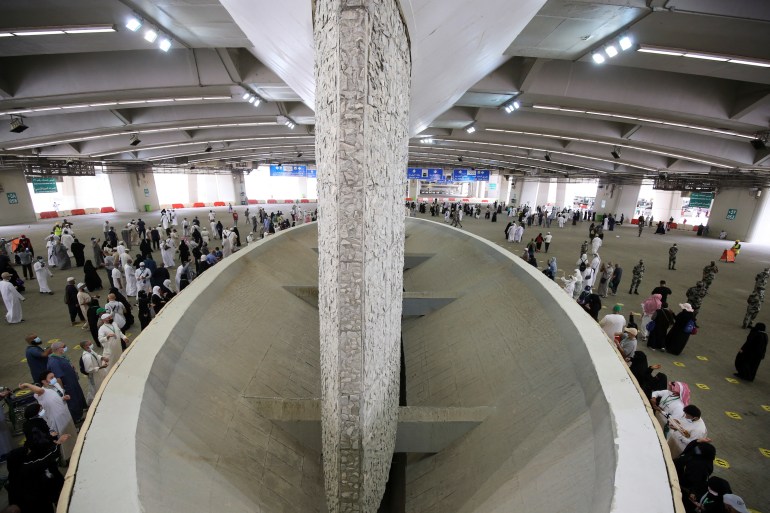More than a thousand tons of pebbles are thrown annually during the Hajj season.
During the Hajj season, pilgrims throw stones at the Jamarat, during the three days of Tashreeq, starting from the small Jamarat, then the middle and then the greater. The pilgrim takes the Jamarat from Mina or Muzdalifah, which is a group of small pebbles.
A group of scholars stated that the wisdom of stoning the Jamarat is to insult Satan, humiliate him, and show his opposition, and to follow the Sunnah of the Noble Prophet - may God’s prayers and peace be upon him - when he, peace be upon him, said: “Take your rituals from me.”
But where do these pebbles go after the pilgrims throw them?
The answer is that it passes through several stages after the pilgrim casts it, as it descends at the bottom and moves on a path to collect it, and it is examined and the Jamarat is selected from others.
At the bottom of the Jamarat Bridge lies the secret of assembly, where the pebbles are lifted with huge belts that pull the existing pebbles, after they are collected in the three Jamarat basin. Opening, closing and determining the path of gravel and its quantities. The system also features sorting sensors to filter and isolate what is thrown from non-gravel.
The amount of coal that is disposed of annually is estimated at about one thousand tons (Reuters)
automated system
The automated lifting system helped to speed up the storage of stones in the basement of the bridge facilities, and the system works - through electronic gates on the floors of the Jamarat Bridge - to transfer them to the compressor vehicles waiting at the depth of the facility located at the bottom of the bridge.
The gravel is then disposed of - as waste - in the approved landfills, and the quantities disposed of, according to official statistics, are estimated at about one thousand tons annually.
Where do the pebbles go after throwing them?
For more.. Follow Al Jazeera's Instagram account @Aljazeera pic.twitter.com/Ioj27Yx8BB
- Al Jazeera (@AJArabic) August 12, 2019
The Jamarat facility is one of the most prominent projects in the Mina area, with a total cost of more than 4.2 billion Saudi riyals (US$3.75), and its capacity to accommodate 300,000 pilgrims per hour. It was 950 meters long and 80 meters wide, and the foundations of the facility were designed to be able to withstand 12 floors, and 5 million pilgrims in the future if the need arises.
The project consists of 5 floors, each 12 meters high, where all support services are available for the convenience of pilgrims, including a ground tunnel for transporting pilgrims so that it separates the movement of vehicles from pedestrians.
The project includes 11 entrances to the Jamarat and 12 exits in the four directions, in addition to providing it with an emergency helipad, ground tunnels, and an advanced cooling system that works with the desert air conditioning system that pumps a kind of mist on the pilgrims and the areas surrounding the Jamarat, which contributes to reducing the temperature to about 29 Degree.
The project is one of the most prominent projects that Saudi Arabia has been keen to implement to provide security and safety for pilgrims, eliminate the risks that occurred in the Jamarat area, and avoid all problems caused by the severe crowding that occurred when stoning the Jamarat.
Jamarat Bridge is one of the most popular facilities that have undergone continuous development (Reuters)
continuous development
Since its construction in 1974, the Jamarat Bridge has witnessed a number of development works, with its width of 40 meters, with two ramps on the eastern and western sides, and two ramps next to Jamarat Al-Aqaba from the upper floors from the northern and southern sides, for the disembarkation of pilgrims.
And continued interest in developing the bridge, to witness in 1978 the implementation of ramps of reinforced concrete (tolls and houses) to the second level of the Jamarat on both sides of the bridge opposite Jamara al-Soghra.
After the pilgrims throw stones at the Jamarat, where do those stones go and how are they disposed of?
Many of you, like me, asked yourself this question..
Yesterday I visited the Jamarat building and had a previous filming of the answer to that question and for the first time it was photographed..
I also knew that the Jamarat Building, with its six floors, is the largest building in the world made of concrete.. pic.twitter.com/4MZlAA2hgw
- Faisal Al-Abdulkarim (@f_alabdulkarim) August 23, 2018
In 1982, the bridge witnessed an expansion by increasing its width to 20 meters and a length of 120 meters from the northern side loyal to Al-Jamrah Al-Soghra. For services on both sides of the bridge and the implementation of directional signs, lighting and ventilation, the total area is 57,600 square meters.
The Jamarat Bridge entered a new stage of organization and development. In 1995, a process of modification was carried out in various stages, in a way that combined the view of the bridge and the representation of the movement of pilgrims on it, followed by similar modifications in 2005, which included the structure of the bridge and the modification of the shape of the basins from circular to oval shape and the modification of the signposts, and the establishment of New emergency exits at Jamarat al-Aqaba and the installation of directional boards that include information to educate pilgrims and warn them in case of crowding.

